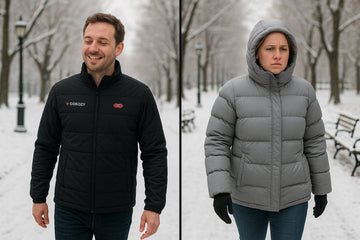Working outdoors in cold weather is tough — it affects comfort, concentration and safety. A good heated vest is not a luxury for people who work in the cold; it’s a practical, everyday tool that improves warmth, mobility and productivity. This article explains why a heated vest is a smart investment for outdoor workers, how to choose the right one, and simple tips to get the most from it.

The real costs of working in the cold
Cold conditions slow hands, stiffen joints and make repetitive tasks harder. Workers who feel cold are more likely to take longer breaks, move cautiously (which reduces productivity) or, worse, make avoidable mistakes. Over time, chronic exposure can also increase the chance of cold-related illnesses and reduce general wellbeing.
Why a heated vest makes sense for outdoor workers
Heated vests are designed to provide targeted, controllable warmth to the body’s core while leaving your arms free for work. Compared with bulky insulated coats, a heated vest keeps you warm without restricting movement — a huge advantage for couriers, construction operatives, warehouse staff and anyone who needs full use of their arms.
- Targeted warmth: heating elements focus on the chest and back to preserve core temperature quickly.
- Low-profile layering: slim fit means the vest works under or over workwear without getting in the way.
- Adjustable control: multiple heat settings let the wearer match warmth to activity level and weather.
-
Portable power: rechargeable batteries provide hours of heat and can be swapped if you need longer shifts.

Practical benefits you’ll notice on the job
Here are the everyday ways a heated vest helps workers in the field:
- Faster warm-up: you feel comfortable within minutes rather than waiting for body heat to build up.
- Consistent comfort: keep steady core warmth so hands and feet stay more responsive.
- Better focus and safety: reduced distraction from cold helps you stay alert and move more precisely.
-
Cost-effective: fewer sick days and fewer layers to launder or replace make vests a sensible long-term purchase.

How to choose the right heated vest for work
Not all heated vests are the same. Use this checklist when comparing models so you pick one that actually improves your working day.
1. Heating coverage and control
Look for a vest that heats the chest and back with more than one heating zone and offers at least three temperature settings. Multi-zone heating gives even warmth and prevents cold spots when you are moving or bending.
2. Battery life and ease of replacement
Check typical run times at different heat levels and whether the battery is removable. For long shifts, a spare battery or a high-capacity option will keep you going. Prefer vests with standard low-voltage, insulated battery designs (for example, 5V systems) for safety.
3. Fit and freedom of movement
Choose a trim, ergonomic cut that sits comfortably under a shell jacket or over a work shirt. Sleeveless design is key: it leaves the arms free for lifting, climbing ladders or handling tools.
4. Durability and care
Workwear needs to be tough. Pick vests made from breathable, wind-resistant fabric and confirm the care instructions — many vests allow the heating elements and battery to be removed so the garment can be machine washed safely.
5. Safety and certifications
Check for overheat protection and short-circuit safeguards. Certifications or clear safety statements from the maker give extra peace of mind when vests are used every day.
Real-world tips for using a heated vest at work
Small adjustments make a big difference in comfort and battery life:
- Start on high, then lower it: switch to a higher setting for the first 10–15 minutes to warm up quickly, then reduce to maintain warmth and save battery.
- Layer sensibly: wear a lightweight, breathable base layer under the vest and a windproof outer layer over it for wet or windy conditions.
- Carry a spare battery: swap mid-shift if you face long hours outdoors.
- Follow care instructions: remove the battery before washing and use the manufacturer’s guidance to keep the heating elements in good condition.
Who benefits most from a heated vest?
Heated vests are particularly valuable for job roles that involve frequent movement outdoors and require dexterity:
- Delivery riders and couriers who are exposed to wind chill.
- Construction workers and site staff who need freedom of movement.
- Warehouse operatives working in cold storage or unheated buildings.
- Farm workers, groundskeepers and anyone working in early-morning low temperatures.
Investment view: cost versus value
While a quality heated vest requires an upfront outlay, the value comes from daily use: fewer layers to buy and maintain, improved productivity, and a lower likelihood of cold-related downtime. For employers, offering heated vests can be a cost-effective way to improve staff comfort and safety, reduce sick days and demonstrate care for staff wellbeing.
Conclusion — practical warmth that works
A heated vest is a straightforward, practical investment for people who work in cold conditions. It delivers immediate warmth, keeps arms free for work, and pays back over time through comfort, safety and improved efficiency. If you or your team spend hours outdoors, a heated vest is worth considering — choose a reliable model with good heating coverage, a removable rechargeable battery and robust construction to get the best long-term value.
Interested in exploring options? Check our heated vest collection to compare features and find the model that fits your working day.





